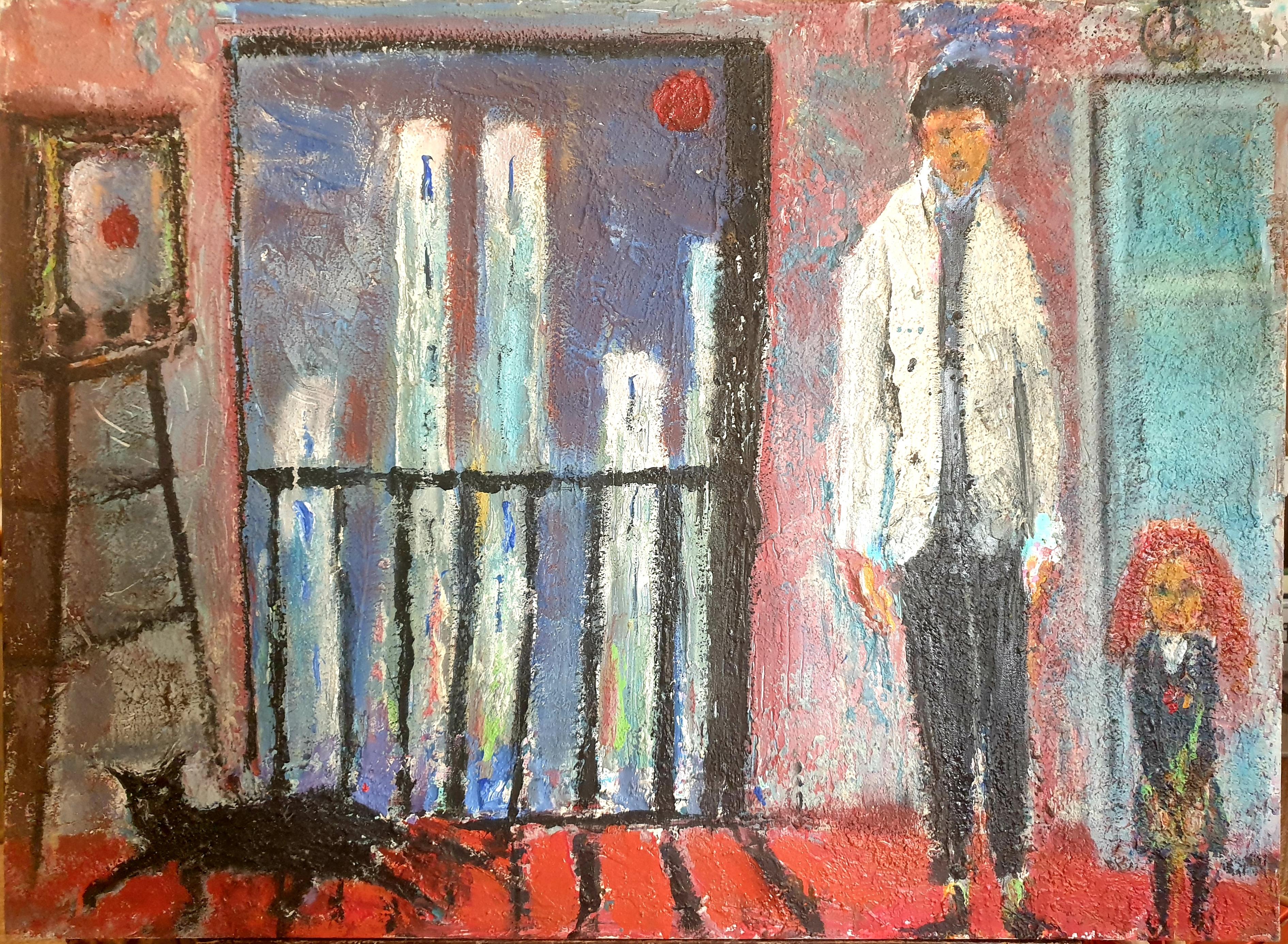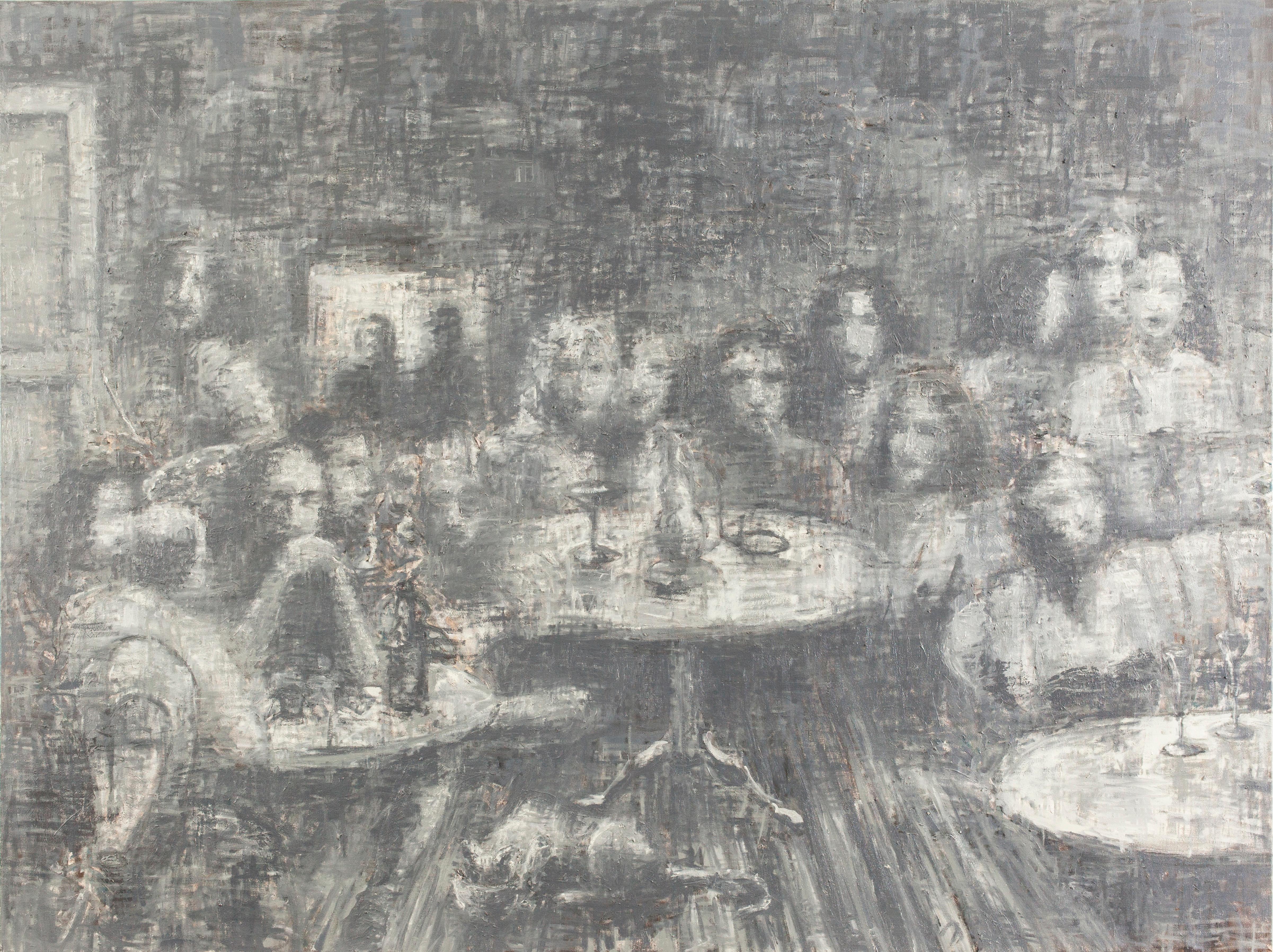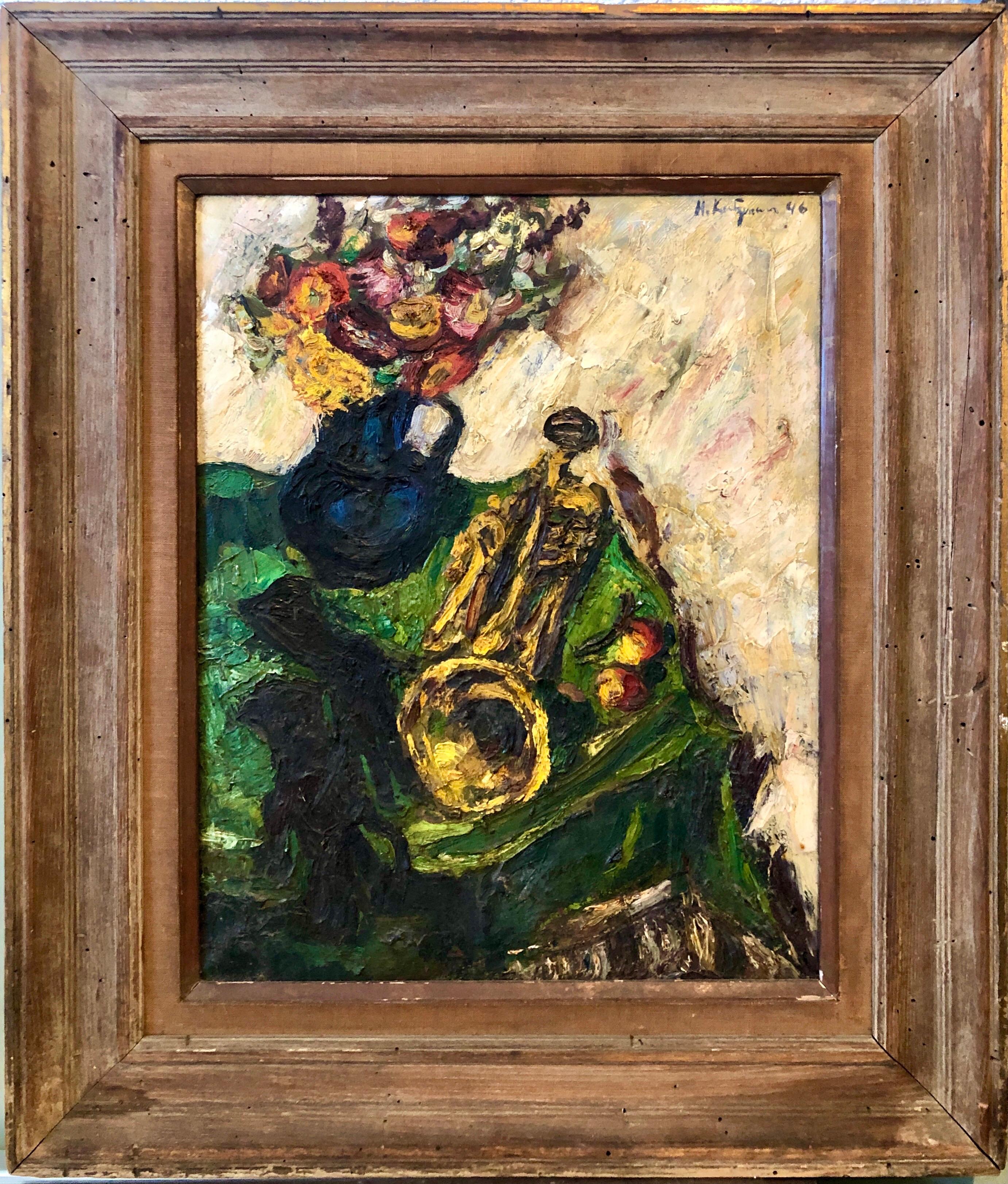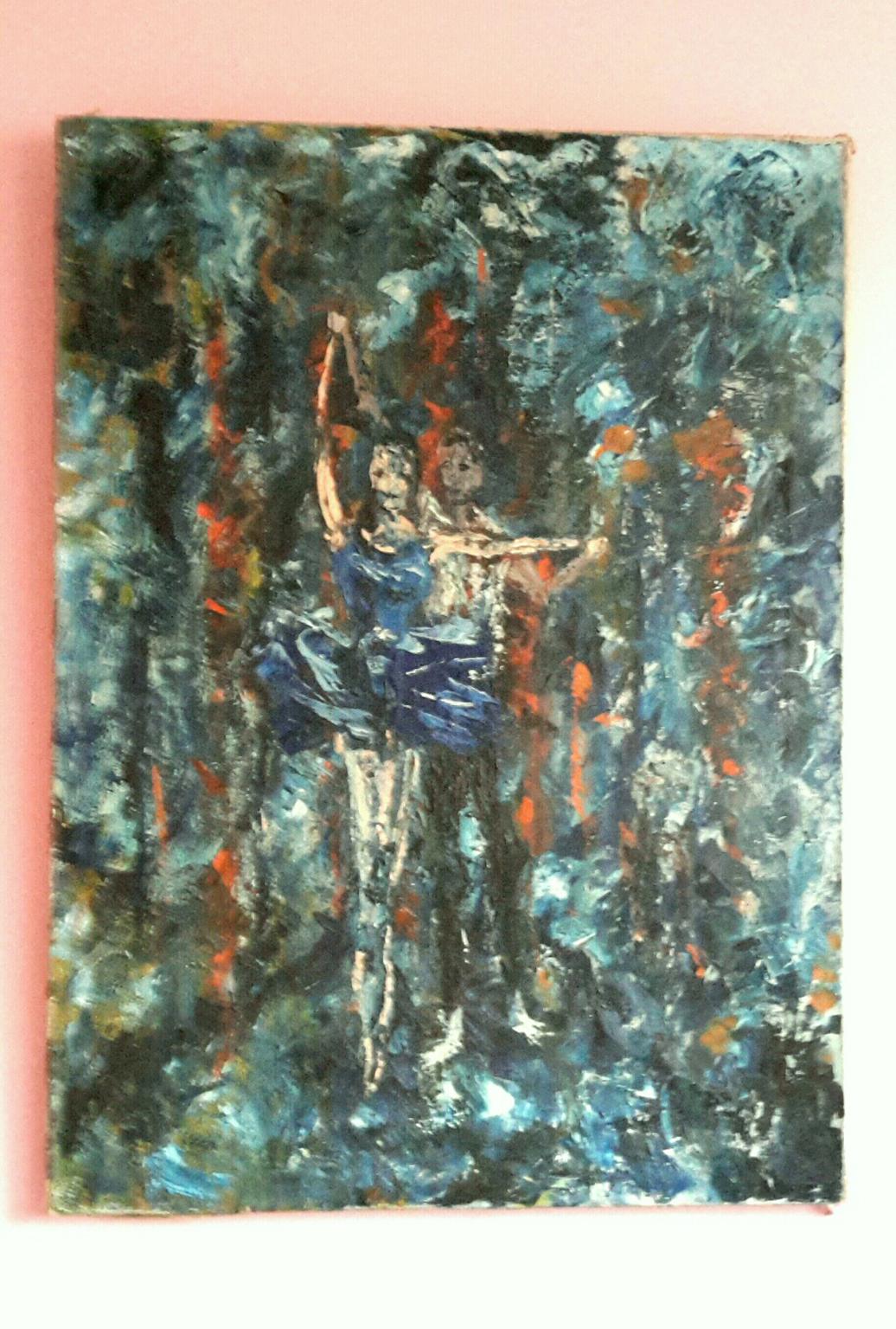Items Similar to Still Life with Blue Vase
Video Loading
Want more images or videos?
Request additional images or videos from the seller
1 of 9
Nahum TschacbasovStill Life with Blue Vase1934
1934
About the Item
Estate of artist.
Russian-Jewish-American artist Nahum Tschacbasov (1899-1984) is known for his intriquing cubo-surrealistic-symbolist works which feature a strong psychological element.
Most art admirers are probably unaware of the Tschacbasov’s prominence in
the United States. Born in Baku, Azerbaijan (a territory of Russia back in 1899), Tschacbasov was an important figure in the New York art world from the 1930s to the 1950s, displaying his intricate, symbolladen works at the Whitney Museum of American Art and the Metropolitan Museum.
Tschacbasov was somewhat of a late starter, moving to Paris in 1932 to study under Adolph Gottlieb, Marcel Gromaire and Fernand Leger. He had his first exhibition in Paris in 1934. He then returned to the US where he joined Rothko and Gottlieb at the Gallery Seccession. He was one of the co-founders of The Ten, a group of socially conscious abstract painters which included Rothko, Gottlieb, Joseph Solman and
Ilya Bolotowsky, among others.
In 1944, he began to work at Stanley Hayter's Atelier 17, a center for surrealistic ideas. Between 1936 and 1943, he had five one-man exhibitions at the ACA Galleries and participated in five group shows. He also exhibited at the Whitney, the Pennsylvania Academy of Fine Arts, the Knox Albright Museum, the Chicago Institute of Fine Art and Corcoran, among others. His work can be found in the permanent collections of
the Met, the Whitney, the Brooklyn Museum and the Jewish Museum.
Tschacbasov slipped off people’s radar in the 60s—we don’t know why—but has recently had several retrospective exhibitions, including at the National Arts Club entitled: "Nahum Tscacbasov: A Retrospective."
- Creator:Nahum Tschacbasov (1899-1984, American)
- Creation Year:1934
- Dimensions:Height: 20 in (50.8 cm)Width: 16 in (40.64 cm)
- Medium:
- Movement & Style:
- Period:
- Condition:Newly framed.
- Gallery Location:Lawrence, NY
- Reference Number:1stDibs: LU149729624552
About the Seller
5.0
Vetted Seller
These experienced sellers undergo a comprehensive evaluation by our team of in-house experts.
Established in 2011
1stDibs seller since 2021
22 sales on 1stDibs
Typical response time: 4 hours
- ShippingRetrieving quote...Ships From: Lawrence, NY
- Return PolicyA return for this item may be initiated within 3 days of delivery.
More From This SellerView All
- Woman Playing the Piano ForteBy Marguerite Stuber PearsonLocated in Lawrence, NYMarguerite Stuber Pearson was a firm proponent of the Boston School tradition, characterized by her mastery of academic technique and the selection of traditional subjects of portraiture, figures in interiors and still lifes. In her debut exhibition at the Guild of Boston Artists in 1931, one reviewer happily reported that her paintings were “executed in the best Boston School tradition.” Upon seeing the show, Edmund Tarbell...Category
1930s American Impressionist Interior Paintings
MaterialsOil
- StudyBy Leonid BalaklavLocated in Lawrence, NYBorn in Ukraine and based in Jerusalem, artist Leonid Balaklav seeks to conduct a dialogue with the works of the great masters such as Caravaggio, Rembrandt and Repin. but using as h...Category
Early 2000s Expressionist Interior Paintings
MaterialsOil
- View From the Artist's Studio, JerusalemBy Leonid BalaklavLocated in Lawrence, NYBorn in Ukraine and based in Jerusalem, artist Leonid Balaklav seeks to conduct a dialogue with the works of the great masters such as Caravaggio, Rembrandt and Repin. but using as h...Category
Early 2000s Expressionist Interior Paintings
MaterialsOil
- Untitled BiomorphicBy Melville PriceLocated in Lawrence, NYEstate stamped and accompanied by a COA from the estate. The history of the New York School painters is still being written, but Price earned a well-deserved place from the beginnin...Category
1940s Expressionist Abstract Paintings
MaterialsOil
- Harlem LaundryBy Jules HalfantLocated in Lawrence, NYOil on board. Notable as a Federal Arts Project artist during the Great Depression of the 1930s, Jules Halfant was part of the mural and easel division of the New York Works Progress Administration (WPA). While in the WPA, he worked alongside such well-known artists as Jackson Pollock, Mark Rothko, Milton Avery and Stuart Davis. Halfant studied at the National Academy of Design from 1924-1927. He participated in New York exhibitions at the ACA Gallery in 1935, and the Artists' Gallery in 1938. He also exhibited with "The New York Group" at ACA Gallery in '38 with Jacob Kainen, Herb Kruckman, Alice Neel, Louis Nisonoff, Herman Rose, Max Schnitzler...Category
1930s American Modern Interior Paintings
MaterialsOil
- InteriorBy Diana KurzLocated in Lawrence, NYThe story of the post-WWII New York School artists is still being written. The role of women in the art of the day still needs examination and study. Kurz is one such example. Diana Kurz (b. 1938) was born into a wealthy Austrian-Jewish family whose business was Aryanized after the Anschluss forcing the family to flee, first to Spain, then across Europe, and finally to the United States. Brought up as a "normal" American girl, Kurz always wanted to be an artist. She studied at Brandeis, at Hunter with Robert Motherwell and received her MFA from Columbia. She received instruction from Hans Hoffmann, studied with Phillip Guston and Phillip Pearlstein...Category
1960s Abstract Expressionist Interior Paintings
MaterialsOil
You May Also Like
- Large Expressionist Oil on Canvas, Apartment Interior and Cityscape.By Ernst Ludwig KirchnerLocated in Cotignac, FRA mid century Expressionist oil on canvas of a man, child and cat in an interior with a cityscape beyond. The work is not signed but there are various notations to the top rear stret...Category
Mid-20th Century Expressionist Figurative Paintings
MaterialsOil, Canvas
- Paul Manes - Palaz of the Hoon, Painting 2008By Paul ManesLocated in Greenwich, CTPaul Manes was born May 4, 1948, in Austin, Texas. He began his professional career in New York City in the early 1980s. His art has been widely exhibited in America and Europe and h...Category
Early 2000s Expressionist Figurative Paintings
MaterialsCanvas, Paint, Oil
- 1950's Expressionist Interior Oil Painting Still Life with Flowers and TrumpetBy Herbert KatzmanLocated in Surfside, FLHerbert Katzman 1923-2004 (American artist active in New york, Illinois and Italy) Oil Painting Dated 1946. Signed. Dimensions; Sight-16" x 20", Frame-23.5" x 27". Provenance: this bears an old stamp verso from Christie's auction house. Herbert Katzman was born in Chicago on Jan. 8, 1923, His father believing that discipline was a good teacher, sent Herbert and Bob to St. John's military academy for their elementary education but it wasn't long before Herbert found his way to the Art Institute of Chicago where he wanted to study sculpting. His Father vehemently objected and refused to finance his studies, but that wasn't enough to discourage the young artist. He put himself through school working as a student janitor and a few other odd jobs. At 17 he entered the Advanced School of the Art Institute, his interest having turned to painting. His study there was briefly interrupted by a short stint in the navy (1942-44). After receiving a medical discharge, he returned to Chicago to work with Boris Anisfeld, who introduced him to German and French Expressionism...Category
Mid-20th Century Expressionist Figurative Paintings
MaterialsOil, Canvas
- Polish French Jewish Artist Oil Painting Girl with Doll, School of Paris JudaicaBy Walter SpitzerLocated in Surfside, FLFramed 27 X 24 inches Sight 18 X 15 inches Walter Spitzer (Polish/French, 1927 - ) born in Cieszyn, Poland. A Polish Jewish Holocaust survivor, he made his first drawings in a concentration camp. Walter Spitzer has lived and worked since WWII in France, where he studied at the École des Beaux Arts in Paris. Walter Spitzer has achieved great renown as a painter and printmaker. Whether in his paintings of Biblical subjects or in lithographs of Shtetl scenes, His humanity was inspired by the writings of Sartre, Montherlant and Kazantzakis, Walter Spitzer is occupied with two great, interlinked themes: man’s inhumanity to man, and the humanity of man. He will surely be recognized in the future as one of the great witnesses to the twentieth-century experience. Walter Spitzer was born in Chieszyn, Poland, the son of a Jewish liqueur producer, and attended the German school there. He began to draw and paint at an early age. In 1939 the Spitzer family was forcibly removed by the Germans to the town of Strzemieszyce, which was turned into a ghetto in 1942. When the ghetto was liquidated in June 1943 Spitzer’s mother was shot, and the sixteen-year-old Walter was deported to Blechhammer, a subcamp of Auschwitz. There he painted portraits of Wehrmacht soldiers and fellow inmates in exchange for food. He was one of the few to survive the evacuation march from Auschwitz to Buchenwald, where to begin with, in late February 1945, he was held in the Little Camp. To enable him to make drawings documenting life in the camp, the Communists organized his transfer to the main camp. While on a death march in early April he made his escape in the vicinity of Jena and was soon in the hands of the Americans. Spitzer served as an interpreter with an American army unit, and at the same time executed numerous drawings depicting the world of the camps. In June 1945 the Americans took him to Paris, where – following the advice of his father, who had died in 1940 – he began to study art at the École des Beaux-Arts in Par the following year. After completing his training as an artist he produced paintings expressing a critical view of the society of his day. In 1955, in commemoration of the camps and the death marches, he executed a cycle of nine etchings in an edition of thirty, which he gave to various museums in Israel and in France. In the 1960s he established himself as an illustrator of exclusive editions of works by such authors as André Malraux, Jean-Paul Sartre, Joseph Kessel and Nikos Kazantzakis. The Six-Day War prompted him to begin painting subjects from Jewish and Biblical history; At age 19, he was asked to make the scenery for the Edouard VII Theater in Paris, which was showing The Dibbuk of Ansky. In 1947 the same theater asked him to make the scenery for the Hill of Life ( Max Zveig). Spitzer has been a member of the Salon d'Automne since 1952. He was the last remaining survivor of the Montparnasse Ecole de Paris. A group of Jewish expats that included Issachar Ber Ryback, Abel Pann, Abraham Mintchine, Isaac Antcher, Alexandre Altmann, Henri Epstein, Mane Katz, Marcel Janco, Gregoire Michonze...Category
1960s Expressionist Figurative Paintings
MaterialsCanvas, Oil
- Large French Expressionist Oil Painting, Girl, Poupèe, the Doll, Ecole de ParisLocated in Surfside, FLSigned on recto and signed verso, titled, and inscribed Montmartre by the artist. This is a large colorful expressionist painting of a girl doll with long blonde or ginger redhead pigtails. It is titled Poupee 1925 and depicts an Art Deco era flapper girl in a beret. Roger Crusat (French Expressionist artist, poet and lithographer) is known for ballet troupe set design and theatre backdrop painting and architectural motifs. Roger Crusat was born in 1917 in Roussillon, Provence, France. Crusat's early works depict the colorful countryside of Provence in the South of France, As a young man Crusat performed many jobs in the troupe, designing costumes, and even dancing. But, most important, he painted the scenery for the troupe's performances. It was while working in this capacity that he learned the essentials of scenery painting that remain evident in his mature work. Crusat was a student of Andre Fons-Godail at Beaux-Arts in Perpignan when he was called to serve in World War II. After being wounded in 1940, he returned to study under Rene Jaudon at Beaux-Arts in Paris. Crusat was known by his contemporaries as "the Catalan painter of Montmartre" where he lived with his wife until his death in 1994. Cracked and peeling walls framed by rusting water pipes are a common sight in Montmartre. What others considered unnecessary, Crusat included. Water pipes were his cherished motif. Supposed by some to be a symbol of decay and monotony, Crusat's Impressionist water pipes like arteries in the body, convey life. Crusat won the prestigious Prix Populiste for his "Descente d'Eau" (Water Pipes) in 1956. Crusat's mature work retains the essentials of good scenery painting. Intricate detail will not be found, but broad, solid abstract shapes abound. His subtle colors, dense in texture, are meant to compliment his subjects, not distract from them. The critics considered him a lyric expressionist and a "painter of Man" in his portrayal of the anguish of daily life and the regrets of the past. Crusat exhibited at many of the same Salons as the post-impressionists and expressionists. Salon des Independants was co-founded by Georges Seurat. Degas had only one exhibition during his lifetime, and it was at the Galerie Durand Ruel in Paris. Gauguin had also exhibited his Tahitian paintings. Crusat's works were exhibited there in 1955. SELECT AWARDS 1954 Le Prix de la Jeune Peintre 1955 Prix des Amateurs d'Art & des Collectionneurs, Galerie Gazette des Beaux Arts, 140 rue Faubourg St. Honore, Paris Les Jardins des Abbesses purchased by the Republic of France, Prix de la Ville de Marseilles, Prix Othon Friesz 1956 Prix Populiste, Prix de Amedeo Modigliani 1957 Grand Prix International de Vichy, Prix de la Fondation Greenshields 1959 IVeme Grand Prix de Peinture du Festival de Vichy 1967 Le Prix des Amis de Brantôme, Perigord, France 1970 Prix de la Critique Academy de Vernet a Vichy,"La Nuit, Premiere Etude" Roger Crusat, Half-closed shutters , poems enriched with four original lithographs (175 numbered copies) drawn on Henri Deprest's presses on February 13, 1975 , Éditions Matignon 34, 1975. Personal exhibitions Durand-Ruel Gallery, Paris, 1955 [ 1 ] . Galerie Rivière, Paris, november 1958 [ 4 ] . Le Roux and Mathias, auctioneers in Paris, Sale of the Roger Crusat workshop , Hôtel Drouot , Paris, Thursday October 27, 1994 [ 5 ] . Jack's American Bistro, Glens Falls , September- october 2004 [ 6 ] . Collective exhibitions Galerie Roger, Lyon , October 1946 [ 7 ] . Salon des Indépendants , Paris, from 1952 [ 8 ] . Exhibition Discover , Galerie Charpentier , Paris, 1955. Populist Salon, Paris, 1956. Salon des Amis de Brantôme, 1957. Hundred painters and oil - Exhibition on the occasion of the centenary of the first oil drilling , Musée Galliera , october 1958 [ 9 ] . “An artist from Roussillon whose invoice calls for a flattering comparison with that of a Soutine or a Rebeyrolle . Indeed, following their example, he focuses on familiar scenes: Girls on the balcony or in the basket , Laundresses weighing heavily on the iron, draft horses or plucked turkeys, who stand next to a magnificent portrait of a man in a red dressing gown . Hasn't the Prix Populiste already crowned its merits? " - Jean Jacquinot SELECT EXHIBITIONS Galerie La Gentilhommiere, Paris La Salle Arago, Perpignan, Salon des Indépendants, Salon d'Automne Biennale de Menton, Menton Galerie des Jacobins, Lyon Galerie Durand-Ruel, Paris Salon de la Nationale Galerie Bassano, Paris Salon Populiste Salon de Romans Galerie Motte, Geneva, Switzerland Exposition à Quiberville sur Mer - Normandie Galerie Charpentier Salon Confrontation: Bernard Buffet, Roger Crusat, Jean Jansem, Franck Innocent, Jean-Jacques Morvan...Category
Mid-20th Century Expressionist Figurative Paintings
MaterialsCanvas, Oil
- Nuit d'orage en FagneLocated in Paris, FRLarge Belgium oil on canvas Expressionist style of the early 20th century depicting a symbolist scene of a couple of ballet dancers in a forest on fire. The painting is signed on the...Category
Early 20th Century Expressionist Figurative Paintings
MaterialsOil





